Resource Center
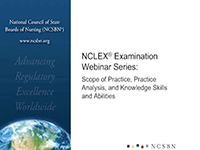
NCLEX Webinar Series: Scope of Practice, Practice Analysis and Knowledge, Skills and Abilities
The Scope of Practice, NCLEX Practice Analysis and Knowledge, Skills and Abilities webinar will cover the beginning principles in the development of the NCLEX examination which is used by nursing regulatory bodies to make primary nursing licensure decisions. The session will also discuss and provide a direct link to valuable NCLEX resources, along with a connection to the next segment in the series.
This webinar is part of the 2013 NCLEX Examinations Webinar Series.
This series includes the following webinars:
- NCLEX Test Plan
- Scope of Practice, Practice Analysis and Knowledge, Skills and Abilities
- NCLEX Item Writing and Item Review
- NCLEX Sensitivity and Differential Item Functioning Review
2013 | Recorded Webinar
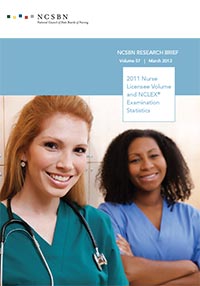
2011 Nurse Licensee Volume and NCLEX Examination Statistics (Vol. 57)
This annual publication provides national and state summary data of member boards’ licensure activities, as well as data on candidate performance on the NCLEX-RN and NCLEX-PN Examinations.
2013 | Publications

Assessing DIF among small samples with separate calibration t and Mantel-Haenszel chi-square statistics in the Rasch model
Published in Journal of Applied Measurement
2013 | Research Item

Preparation, Roles, and Perceived Effectiveness of Unlicensed Assistive Personnel
The use of unlicensed assistive personnel (UAP) in hospitals has increased over the last 20 years. In lieu of regulation of UAP by boards of nursing, many health care agencies and organizations have developed their own educational standards, role definitions, and scopes of practice for UAP in acute care. The purpose of this study was to explore how UAP are used in acute care settings and how their work is perceived by nurses who work with them and by themselves. The results of this mixed method design study showed many similarities among UAP titling; however, there were substantial variations in educational preparation and use of UAP, especially as they move into advanced or specialty areas. Nevertheless, both registered nurses and UAP perceive the work of UAP to be highly effective. Additional collaborative research by regulatory and health care agencies is recommended. This research should be used to inform the development of regulations for educational preparation and utilization of these providers.
2013 | Research Item

Prelicensure RN Students With and Without Criminal Histories: A Comparative Analysis
The purpose of this study was to determine whether certain key outcomes differ between preRN licensure students who have a criminal history and those who do not. Outcomes examined were program completion, NCLEX-RN ® passage, subsequent criminal acts, and subsequent professional misconduct. A retrospective descriptive-comparative research design was used. The sample consisted of 3,166 applicants from the 2006 cohort of preRN licensure students in Louisiana who met the criteria for inclusion in the study. Analysis of the data revealed 10% of participants with a criminal history had a subsequent criminal incident, whereas only 3.4% of the noncriminal history group had a subsequent criminal incident. Additionally, 4.5% of the criminal history group had subsequent professional misconduct compared with 1% of the noncriminal history group.
2013 | Research Item

State Regulatory Oversight of Certified Nursing Assistants and Resident Outcomes
This study aimed to describe state regulatory certified nursing assistant (CNA) oversight in two domains—use of registry or licensing for credentialing and initial CNA training and continuing education (CE) requirements—and to evaluate whether CNA oversight is associated with resident outcomes in nursing homes. This cross-sectional secondary analysis combined 2004 data on state-level regulatory requirements for CNA oversight, training, and CE with nursing home resident outcomes data collected in 2004 from 16,125 U.S. facilities in 49 states. Though 26 states required CNAs to have more initial training hours than the federal requirement of 75 hours, only four states required additional yearly CE hours to maintain CNA certification. The combination of increased initial training and annual CE hours was significantly associated with nursing homes reporting lower antidepressant and antipsychotic use and lower average medication use. Use of a registry or licensing board for credentialing was significantly related to lower catheter use, and CNA licensure was significantly associated with lower odds of falls. Findings suggest that regulatory modifications could be beneficial to improve resident care outcomes in nursing homes.
2013 | Research Item

Foreign-Educated Nurses: Effects on Nurse, Quality of Care, and Patient-Safety-Indicator Outcomes
Approximately 8% of nurses in the United States were educated abroad, and in Florida and California, foreign-educated nurses (FENs) represent large percentages of the nurse labor force. It is important to know whether these nurses are prepared to care for patients who have complex needs; communicate successfully with other nurses, physicians, patients, and families; adapt to high technology in today's acute-care settings; and successfully transition to practice in the United States. It has been noted there is no comparative outcomes research on FENs and U.S.-educated nurses. The purpose of this study was to examine the effects of hospitals' proportions of FENs on nurse outcomes, hospital quality of care, perceptions of work environment, and patient-safety incidences.
2013 | Research Item

Highlights of the National Workforce Survey of Registered Nurses
Over the past 3 decades the Health Resources and Services Administration has reported on the supply of registered nurses (RNs) through theNational Sample Survey of Registered Nurses (NSSRN). Data collection from the most recent, and final, NSSRN was completed in 2008; hence, there is no current data on the nationwide supply of RNs. This current project was conducted by the National Council of State Boards of Nursing and the Forum of State Nursing Workforce Centers to fill this ongoing need and is titled, The National Council of State Boards of Nursing and The Forum of State Nursing Workforce Centers 2013 National Workforce Survey of RNs. This article presents the highlights of the study and its results.
2013 | Research Item

A Multi-State Assessment of Employer-Sponsored Quality Improvement Education for Early-Career Registered Nurses
For RNs to participate effectively in hospital Quality Improvement, they must have adequate QI knowledge and skills. This descriptive study assessed employer-sponsored QI education and RNs' preparedness across a wide range of QI steps and processes. RNs from 15 US states who were employed in hospitals and were initially licensed to practice in 2007 to 2008 were surveyed. Findings revealed the QI education offered by employers to RNs could be substantially improved. Nurse educators play a critical role in making these improvements.
2013 | Research Item
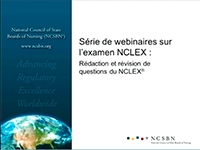
Série de webinaires sur l’examen NCLEX: Rédaction et révision de questions du NCLEX
Le webinaire Rédaction et révision de questions du NCLEX donne un aperçu du processus d’élaboration des questions. Il explique les processus qui sont appliqués à la rédaction et à la révision des questions pour obtenir un examen NCLEX valide, fiable et défendable sur le plan juridique. La séance présente également des ressources très utiles sur le NCLEX et des liens directs vers ces ressources, de même qu’un lien vers le segment suivant de la série.
2013 | Recorded Webinar
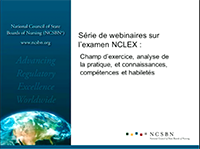
Série de webinaires sur l’examen NCLEX: Champ d’exercice, analyse de la pratique, et connaissances, compétences et habiletés
Le webinaire Champ d’exercice, analyse de la pratique, et connaissances, compétences et habiletés porte sur les principes fondateurs de l’élaboration du NCLEX, l’examen sur lequel s’appuient les organismes de réglementation de la profession infirmière pour prendre des décisions relativement à l’attribution de l’autorisation d’exercer. La séance présente également des ressources très utiles sur le NCLEX et des liens directs vers ces ressources, de même qu’un lien vers le segment suivant de la série.
Ce webinaire fait partie de la série de webinaires de 2013 sur les examens NCLEX.
La série comporte les webinaires suivants:
- Plan de l’examen NCLEX
- Champ d’exercice, analyse de la pratique, et connaissances, compétences et habiletés
- Rédaction et révision des questions du NCLEX
- Analyse de la sensibilité et analyse des biais de mesure différentiels du NCLEX
2013 | Recorded Webinar
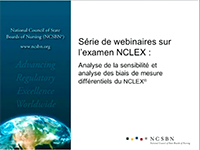
Série de webinaires sur l’examen NCLEX: Analyse de la sensibilité et analyse des biais de mesure différentiels du NCLEX
Le webinaire Analyse de la sensibilité et des DIF porte sur les processus d’analyse des biais de mesure différentiels et de révision des questions. Le webinaire décrit l’objectif des processus et procédures appliqués à la révision des questions pour résoudre les aspects liés à la sensibilité et aux DIF. La séance présente également des ressources très utiles sur le NCLEX et des liens directs vers ces ressources, de même qu’un lien vers le segment suivant de la série.
2013 | Recorded Webinar
